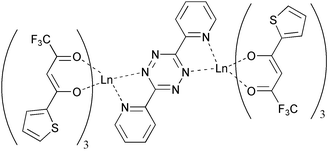Visible-light sensitisation of near-infrared luminescence from Yb(iii), Nd(iii) and Er(iii) complexes of 3,6-bis(2-pyridyl)tetrazine
Abstract
Reaction of the potentially bis-bidentate bridging

* Corresponding authors
a
School of Chemistry, University of Bristol, Cantock's Close, Bristol, UK
E-mail:
mike.ward@bristol.ac.uk
b
Department of Chemistry, University of Manchester, Oxford Road, Manchester, UK
E-mail:
stephen.faulkner@man.ac.uk
Reaction of the potentially bis-bidentate bridging

 Please wait while we load your content...
Something went wrong. Try again?
Please wait while we load your content...
Something went wrong. Try again?
N. M. Shavaleev, S. J. A. Pope, Z. R. Bell, S. Faulkner and M. D. Ward, Dalton Trans., 2003, 808 DOI: 10.1039/B300294B
To request permission to reproduce material from this article, please go to the Copyright Clearance Center request page.
If you are an author contributing to an RSC publication, you do not need to request permission provided correct acknowledgement is given.
If you are the author of this article, you do not need to request permission to reproduce figures and diagrams provided correct acknowledgement is given. If you want to reproduce the whole article in a third-party publication (excluding your thesis/dissertation for which permission is not required) please go to the Copyright Clearance Center request page.
Read more about how to correctly acknowledge RSC content.
 Fetching data from CrossRef.
Fetching data from CrossRef.
This may take some time to load.
Loading related content
